Pershore AGS Show, 2010
This year’s Pershore Show came at the end of one of the longest periods of hot dry weather in England and Wales for many years and as a result expectations were low regarding the number and quality of plants that would be exhibited. However, as usual such negative thoughts were dispelled upon entering the show hall as the benches were well stocked with excellent plants of many different kinds, some rarely seen before.
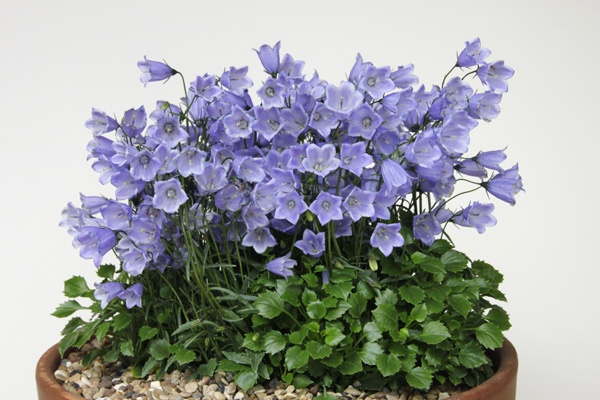
As is expected in a midsummer show, members of the campanula family were much in evidence, with splendid specimens of a wide range of Campanula species and hybrids, including a nice potful of the common and easy, but no less beautiful for that, Campanula pusilla, whose vernacular name of ‘Fairy’s Thimble’ precisely describes its appeal. This was among many excellent exhibits shown by Ann Vale who won the Florence Baker Memorial Trophy for most prize points in the Intermediate Section.
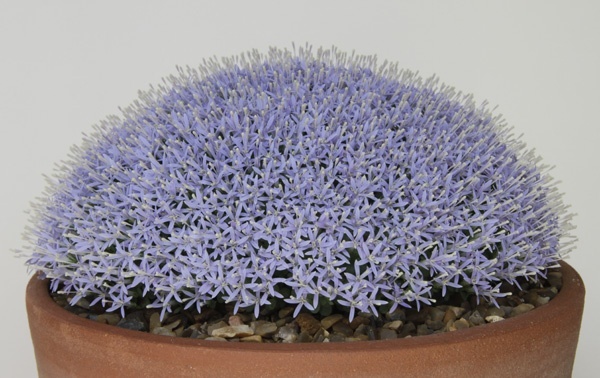
Another member of the Campanulaceae won the premier award for ‘Best in Show’, and it was a particularly welcome result as the exhibitor of the impeccable 20 cm. cushion of Trachelium asperuloides that wowed the judges was exhibited by none other than the new Show Secretary, Eric Jarrett, who also showed many other prize-winning plants. Your reporter can only assume that at the end of a very hot and for him exhausting day, Eric took a well earned nap in a cool, quiet corner! The natural habitat of T. asperuloides is limestone rock crevices in southern Greece and this gives a good hint as to its needs in cultivation. While it can be grown outside without protection in a tight rock crevice, or preferably in a hole in a block of tufa, in wetter climates such as ours it fares better with some winter protection and is perhaps best of all grown as exhibited, in freely draining compost in a pot. Seed is usually the only means of increase as there is generally very little suitable material for cuttings on such a freely-flowering plant.
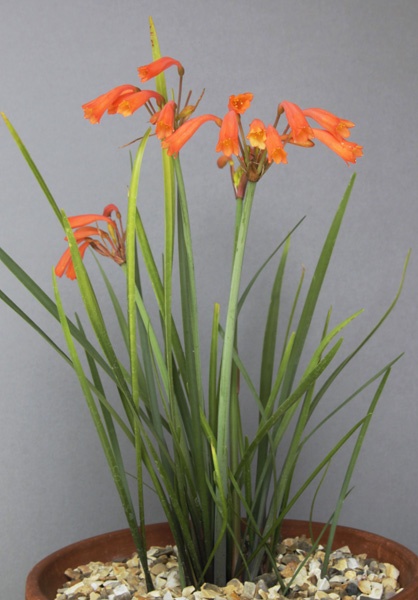
Whenever Cecilia Coller makes one of her frequent forays west from East Anglia other exhibitors in the Open Section need to look to their laurels, and this was no exception. Once again she was the winner of most first prize points and hence claimed the Hilliard Cup. I could easily have filled this report with pictures and accounts of her plants, but two will have to suffice. Cyrtanthus brachyscyphus is one of the many species in this large genus of the Amaryllidaceae family native to South Africa. Species are found growing in a wide range of habitats including damp bushy stream-edges, as epiphytes on other plants, and in near desert conditions. Unfortunately they are rarely seen in cultivation, and are perhaps not sufficiently known, ever to become popular. A few species, including C. brachyscyphus, adapt well to general cultivation, the natural habitat in its case being moist grassland or rocky stream banks in the Eastern Cape and KwaZulu-Natal. Although it is not as flashy or as big as most other species, it is one of the easier ones to grow, with nice orange flowers produced in succession for a long period through late spring and summer, and if kept moist and frost-free is often evergreen in cultivation.
.
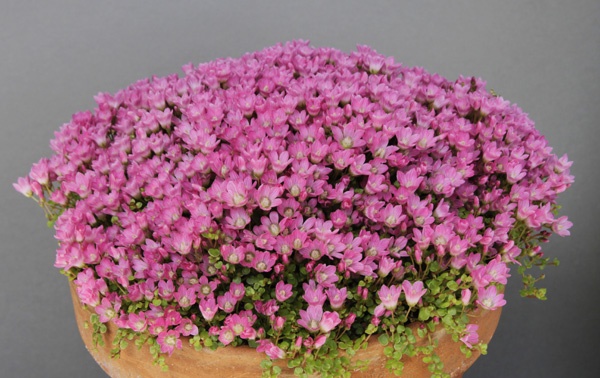
Cecilia also claimed the E.B. Anderson Prize for 6 pans of rock plants, not more than two to be of any one genus, among which she showed one of your reporter’s favourite British native plants, the Bog Pimpernel (Anagallis tenella), an inhabitant of damp heaths and wet acid pastures, predominantly in the west of Britain. A good patch in full flower can easily be the size of a dinner plate and when it is the predominant flowering plant on a site a memorable floral experience is assured. Such memories come flooding back when the plant is seen gracing the show benches. The form most commonly grown and shown is called ‘Studland’ after the Dorset heathland nature reserve on which it was found. The flowers are larger than usual and of a brighter, darker pink. Bog Pimpernel is not a difficult plant to grow provided the soil in which it is growing is never allowed to dry out, being kept moist rather than wet when the plant dies back for the winter. It grows fast but is not long-lived, but as the shoots often root as they go, or can be detached and rooted with ease, it is easily kept.
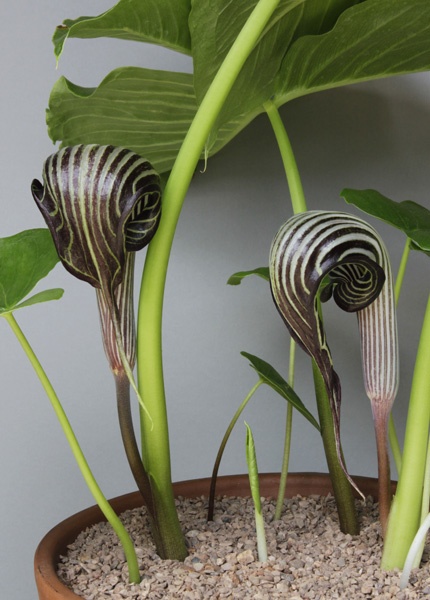
You either like aroids or you don’t, and like Diane Clements, who shows a wide variety through the season, I do. Arisaema is a very large genus in this family, mostly sub-tropical but with many hardy or near-hardy species that are becoming ever more available. One of Diane’s offerings at this show which took my fancy was the very striking A. franchetianum , the aptly named Cobra Lily. This was discovered in shaded rock crevices in Yunnan, China. Its large spathe is deep maroon and fancily striped white, with its hood curled over and down in front of the club-like spadix. The long brown tail trails from the end of the hood. Three-part leaves are large and glossy, adding bold texture even when not in flower. Like many woodland plants, which covers most arisaemas, this species prefers organically-enriched, moist soils. Plants are easily raised from fresh seed, which generally germinates freely with a little warmth, but plants are unlikely to reach flowering size in less than 3 years, perhaps longer.
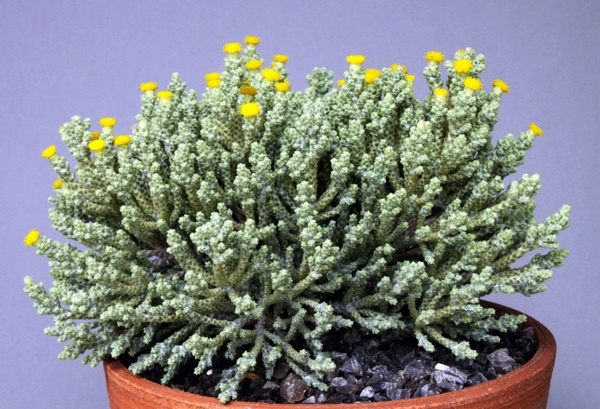
It was remarked by many at the Show that plants which rarely flower in cultivation in the UK, or do so only sparsely, were putting on an especially good show this season, and there was something of a consensus that the long cold winter was responsible. One such plant, again shown by Eric Jarrett, which exhibited plenty of its small, bright yellow, ‘shaving brush’ flower heads was Helichrysum plumeum. This is a slow-growing shrub in the aster family from new Zealand that is easy to cultivate and attractive in a quiet sort of way, with its silver-hairy, coral-like branches. It may not be fully hardy in very cold districts but generally comes through the winter in the open in most parts of the UK without protection. Cuttings taken in July root quite readily in silver sand or fine perlite.
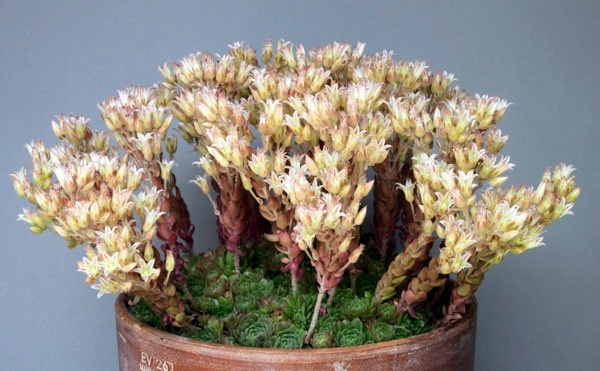
A beautiful plant of special ecological interest was Rosularia serpentinica, shown by Tony Hale in the Intermediate Section. There are two reasons for its appeal to ecologists: as its name implies it occurs chiefly (though not apparently exclusively) on serpentine rocks that contain high levels of heavy metals such as chromium and cobalt, that make them inhospitable to most plants; it occurs on only one mountain range, the Sandras Mountains in Southern Anatolia, Turkey. Being a succulent its main requirement is that it should be grown in full sun and with perfect drainage at the roots. Detached rosettes root easily and quickly in pure sharp sand and a nice potful or patch in a rock crevice can soon be achieved.
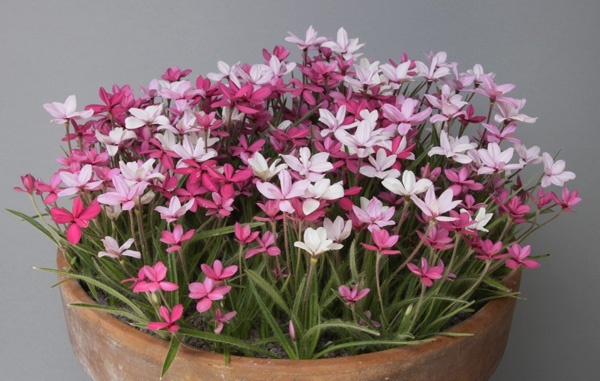
One of our unsung, hard working show photographers, Jon Evans, staged one of the most admired exhibits at this show, a large panful of Rhodohypoxis baurii in mixed colours. This was an unusual exhibit because show rules generally proscribe the exhibition of more than one variety of a plant in a single pot. Whether according to schedule or not, the resulting panful provided a very attractive exhibit. Rhodohypoxis are bulbous plants from South Africa that are equally at home in a shallow pan, a trough, or a very well-drained rock garden, Rhodohypoxis baurii is at its best in June. A tuft of grassy leaves appears in May from each rhizome and is followed by a cluster of flowers that can give a colourful display for a several weeks. It is often said that this plant needs to be kept quite dry after the leaves start to die down in late summer, but in N. Wales, which can hardly be regarded as having a dry climate, plants flourish in raised beds in the open with no protection whatever.
John Good








